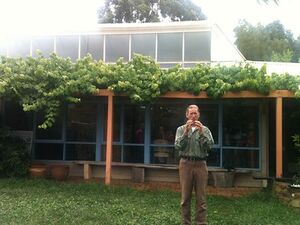
David Holmgren (born 1955) is an Australian ecologist and writer, and the co-originator of the concept of permaculture (with Bill Mollison, who was his academic supervisor).
Holmgren studied at the College of Advanced Education in Hobart, Tasmania, and in 1972 he met Bill Mollison, a lecturer at the University of Tasmania. They shared a strong interest in the relationship between human and natural systems. Out of this, Holmgren wrote the manuscript that was to be published as Permaculture One (1978), which contained insights on agriculture, landscape architecture and ecology:
- 'I wrote the manuscript, which was based partly on our constant discussions and on our practical working together in the garden and on our visits to other sites in Tasmania... I used this manuscript as my primary reference for my thesis, which I submitted and was passed in 1976.'[1]
Holmgren has stated:
- 'The word permaculture was coined by Bill Mollison and myself in the mid-1970s to describe an "integrated, evolving system of perennial or self-perpetuating plant and animal species useful to man". A more current definition of permaculture, which reflects the expansion of focus implicit in Permaculture One, is "Consciously designed landscapes which mimic the patterns and relationships found in nature, while yielding an abundance of food, fibre and energy for provision of local needs". People, their buildings and the ways they organise themselves are central to permaculture. Thus the permaculture vision of permanent (sustainable) agriculture has evolved into one of permanent (sustainable) culture.'[2]
Holmgren was more circumspect than some other permaculturists about the potential of permaculture to live up to promises sometimes made about it. He worked on testing and refining it.
His company Holmgren Design Services has worked on many projects - the report Trees on Treeless Plains: Revegetation Manual for the Volcanic Landscapes of Central Victoria (1994) covers some of these.
In December 2002 he published Permaculture: Principles and Pathways beyond Sustainability,[3] which draws on Howard T. Odum'sW vision of energy transition. It outlines twelve key permaculture design principles.
Holmgren has an interest in the use of non-native plants not only for food and fiber, but also for ecological restoration and "ecosynthesis",W which is more controversial. Holmgren has commented that "The science of ecology provided the overwhelming evidence that everything is connected, so it is a great irony that conservation biology is now dominated by an orthodoxy that is blind to ecosynthesis as nature's way of weaving a new tapestry of life."[4]
Fryer's Forest Ecovillage[edit | edit source]
The design and development of the rural settlement, Fryer's Forest Ecovillage,W by Holmgren and his company, is based on Permaculture principles. The settlement is near Castlemaine, Central Victoria, Australia. It includes domestic forestry with selective thinning for fire-safety, using the wood for domestic wood stoves and the Keyline Design system of water storage and transfer. The landscape is being regenerated after 50 years of gold mining.
The design is a practical test of the ability of a small scale designs to cope with climate variation such as drought.
Bibliography[edit | edit source]
- 1978 Mollison, Bill and David Holmgren. Permaculture One: A Perennial Agriculture for Human Settlements. Melbourne: Transworld.
- 1985 Permaculture in the Bush. Hepburn, Victoria: Holmgren Design Services.
- 1994 Trees on the Treeless Plains: Revegetation Manual for Volcanic Landscapes of Central Victoria. Hepburn, Victoria: Holmgren Design Services.
- 1995 'The Permaculture Movement and Education', in Goldfields Permaculture and Landcarers, 3, 14-16.
- 1996 a Melliodora (Hepburn Permaculture Gardens): Ten Years of Sustainable Living. Hepburn, Victoria: Holmgren Design Services.
- 1996 b 'Fryers Forest Village', in Green Connections, 2.2, 20-21.
- 1997 'Getting Started', in Green Connections, 10, 28-31.
- 2002 a Permaculture: Principles and Pathways Beyond Sustainability. Hepburn, Victoria: Holmgren Design Services.
- 2002 b David Holmgren: Collected Writings 1978-2000. [CD] Hepburn, Victoria: Holmgren Design Services.
- 2005 Mellidora (Hepburn Permaculture Gardens): A Case Study in Cool Climate Permaculture 1985 - 2005 [eBook] Hepburn, Victoria: Holmgren Design Services.
- 2006 a Trees on the Treeless Plains: Revegetation Manual for Volcanic Landscapes of Central Victoria. [eBook] Hepburn, Victoria: Holmgren Design Services.
- 2006 b David Holmgren: Collected Writings & Presentations 1978 - 2006 [eBook] Hepburn, Victoria: Holmgren Design Services.
- 2009 Future Scenarios. White River Junction, VT: Chelsea Green Publishing Company.
- 2018 RetroSuburbia: the downshifter's guide to a resilient future, Melliodora Publishing.
Notes and references[edit | edit source]
External links[edit | edit source]
- Wikipedia:David Holmgren
- http://www.holmgren.com.au
- Holmgren talks about about 'retrofitting the suburbs' for food production - Sydney Morning Herald.
The following links need to be checked for relevance, and kept or removed as appropriate:
- Future Scenarios: Mapping the Cultural Implications of Peak Oil and Climate Change
- Peak Oil and Permaculture: David Holmgren on Energy Descent
- Peak Oil and Permaculture: David Holmgren Video
- David Holmgren speaks with GPM's Julian Darley
- Retrofitting the Suburbs for Sustainability
- Permaculture principles